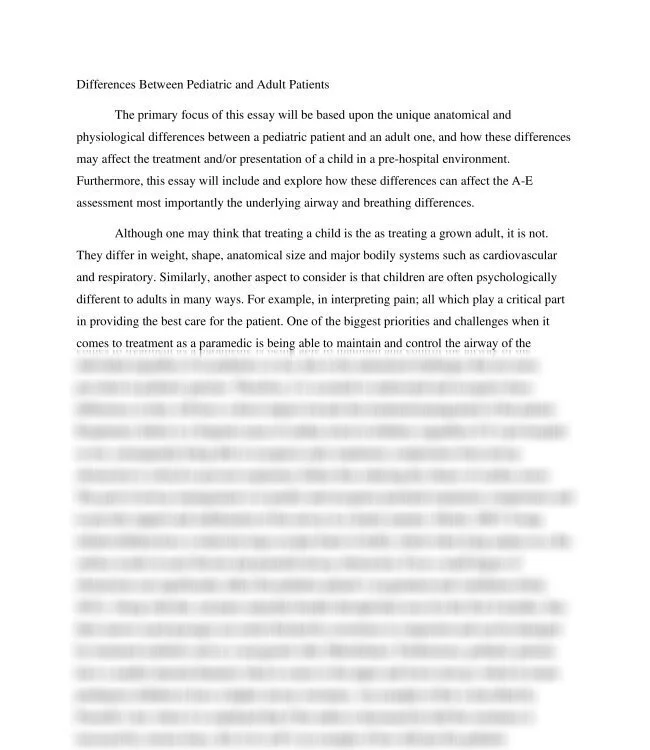Differences Between Pediatric and Adult Patients
Differences Between Pediatric and Adult Patients
& (2006). (2007). (2008). (2010). (2012). (2013). (Adewale, (Anatomical (Derek, (Kache, (Macfarlane). (Pediatric (Santillanes, (Seid, (Weathers, (back (n.d.). -7th 1 1, 1-3 12-16 2007) 2008) 2010) 2012) 2012). 2013). 2014, 28, 2nd–3rd 3 30 30, 4 40% 6 60 6th A A-E A. AIRWAY.pdf Additionally, Adewale, Adult Airway Airway. Along Although An Anaesthesia Anaesthesia. Anaesthesiolgy: Anaesthetic Anatomical Anatomy And Assesment, Assesment. Assessment. Basic Basics: Beach Between Beyond Breathing CONSIDERATIONS Care Center: Children, Children. Clinical Compared Conclusion Considerations Critical D. Davey, Departments Derek, Differences EMS Elsevier. Emergency Equipment. Europian Even Evidence. F. Fire For Furthermore Furthermore, G. In Infants J. Kache, Krost, L. Long Macfarlane, Managment. March Medical Medicine Medicine: OF One PAEDIATRIC PAediatric PHysiology Paedatircs Paediatic Paediatric Paramedic: Patients Pediatric Pediatrics,: Physiological Physiology. Ponselle’s References Regional Respiratory Retrieved S. Santillanes, School Science Similarly, Society Springer. Standford THE The Therefore, They This Training UK: W. Ward’s When World: Young a ability able about accessory account act acute adipose adolescence adolescence; adult adult, adult. adults adults, adults. adult’s affect age airway airway, airway/breathing airways all also amount amounts an anatomical and and/or another approximately are area around arrest arrest. as aspect assessment at attributed aware balance based be being best between biggest blocked bodies bodily body breathe breathing breaths but by can carbon cardiac cardiovascular care cause causes cerebrate. cervical challenges chance child children children, children. child’s clear close comes comparably compared comparison compromise conditions congestion consequently consider consume consumption control core counterparts coupled critical damaged deal decreased degree delicate depend described develop developed developing diameter diaphragm diaphragm; differ difference differences differences. different difficult difficulties dioxide direct distress distress. distribution drop dropping due early easier easily environment. essay essential even example example, explained explore fact factors failure failure. fatigue. fibers first flat flexion focus following for four frequent from fully functional further further.Interesting glucose, glycogen goal greatly groups grown half has have having head head, heat higher how http://blog.utp.edu.co/maternoinfantil/files/2010/08/V%C3%ADa-a%C3%A9rea-en-pediatr%C3%ADa.pdf http://peds.stanford.edu/Rotations/picu/pdfs/10_Peds_Airway.pdf http://www.anaesthesiauk.com/documents/paedsphysiol.pdf http://www.emergencymedicalparamedic.com/anatomical-and-physiological-differences-in-children/ http://www.emsworld.com/article/10322897/beyond-the-basics-pediatric-assessment?page=2 http://www.euroespa.org/klant_uploads/berlinlectures/ANATOMICAL http://www.lbfdtraining.com/Pages/emt/sectiond/pediatricassessment.html hypoglycemia hypoglycemic. hypothermia hypothermia. hypoxia if impact importantly in include increased individual infant infants infants. infants/children inflammation insulation intercostal internal interpreting intubation is is, it its it’s just large largely larger larynx law leads leave like livers looked loss lower lying maintain major making management manner. many may metabolic methods mild miniature minute moderate months, more most much muscle muscles muscular narrow nasal nasogastric naturally neck neonates non-functional nose not not, not. obstruction obstruction. occiput of often old older on one one, only opposed or out output, over oxygen oxygenation pain; paramedic part particularly passages patient patient, patient. patients patients. patient’s pediatric pediatrics pediatrics. per percentage physiological play point position potential pre-hospital predict predispose predisposed present present. presentation presented prevalent prevent primary priorities probability produce production projectile prone proper provide providing psychologically puts quite radius rapid rate ratio recognize reduced reducing regardless relation relative relatively reliant resistance resistance. respiratory respiratory. rest result results return risk role said secretions self severe shape, shiver significantly simplest sits situation. situations sixteen size skeletal skull); slow-twitch small smaller some stabilization store stored stressed such supine supply support surface system systems teenager temperature temperature, tend than that the their these they think this this, through thus timely times times, tissue to towards treating treatment treatment, treatment/management tube twice two. type typically unable unbalanced underlying understand unique unlikely up upon upper usually vary vasoconstriction ventilation veritable, view visualization vital volume ways. weight weight, weight.(Davey, when where which who will with years you young younger
Differences Between Pediatric and Adult Patients
The primary focus of this essay will be based upon the unique anatomical and physiological differences between a pediatric patient and an adult one, and how these differences may affect the treatment and/or presentation of a child in a pre-hospital environment. Furthermore, this essay will include and explore how these differences can affect the A-E
